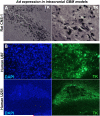Gene Therapy for the Treatment of Neurological Disorders: Central Nervous System Neoplasms
- PMID: 26611605
- PMCID: PMC4677484
- DOI: 10.1007/978-1-4939-3271-9_31
Gene Therapy for the Treatment of Neurological Disorders: Central Nervous System Neoplasms
Abstract
Glioblastoma multiforme (GBM) is the most common primary brain tumor in adults with a median survival of 16.2-21.2 months post diagnosis (Stupp et al., N Engl J Med 352(10): 987-996, 2005). Because of its location, complete surgical resection is impossible; additionally because GBM is also resistant to chemotherapeutic and radiotherapy approaches, development of novel therapies is urgently needed. In this chapter we describe the development of preclinical animal models and a conditionally cytotoxic and immune-stimulatory gene therapy strategy that successfully causes tumor regression in several rodent GBM models.
Keywords: Adenoviral gene therapy; GBM models; Immunotherapy; T cell activation assays.
Figures




References
-
- Stupp R, et al. Radiotherapy plus concomitant and adjuvant temozolomide for glioblastoma. N Engl J Med. 2005;352(10):987–96. - PubMed
-
- Radaelli E, et al. Immunohistopathological and neuroimaging characterization of murine orthotopic xenograft models of glioblastoma multiforme recapitulating the most salient features of human disease. Histol Histopathol. 2009;24(7):879–91. - PubMed
MeSH terms
Grants and funding
- UL1 TR000433/TR/NCATS NIH HHS/United States
- R21-NS084275/NS/NINDS NIH HHS/United States
- R01 NS054193/NS/NINDS NIH HHS/United States
- R01-NS054193/NS/NINDS NIH HHS/United States
- R01 NS082311/NS/NINDS NIH HHS/United States
- R01 NS074387/NS/NINDS NIH HHS/United States
- U01 NS052465/NS/NINDS NIH HHS/United States
- T32-NS007222/NS/NINDS NIH HHS/United States
- R01 NS061107/NS/NINDS NIH HHS/United States
- U01-NS052465/NS/NINDS NIH HHS/United States
- U01-NS052465-S1/NS/NINDS NIH HHS/United States
- R21 NS084275/NS/NINDS NIH HHS/United States
- T32 GM007863/GM/NIGMS NIH HHS/United States
- T32 CA009676/CA/NCI NIH HHS/United States
- T32 NS007222/NS/NINDS NIH HHS/United States
- R01-NS057711/NS/NINDS NIH HHS/United States
- 2UL1-TR000433/TR/NCATS NIH HHS/United States
- R01 NS057711/NS/NINDS NIH HHS/United States
- T32-GM007863/GM/NIGMS NIH HHS/United States
- R01 NS096756/NS/NINDS NIH HHS/United States
- R01-NS074387/NS/NINDS NIH HHS/United States
- UL1 RR024986/RR/NCRR NIH HHS/United States
- T32-CA009676/CA/NCI NIH HHS/United States
LinkOut - more resources
Full Text Sources
Other Literature Sources
Medical

